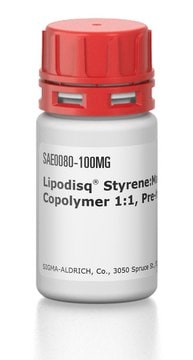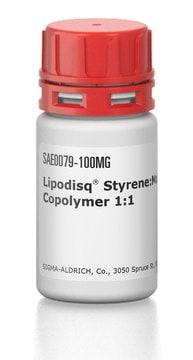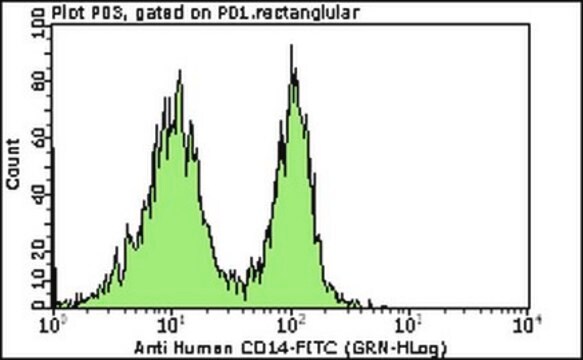SAE0062
Lipodisq®
Styrene:Maleic Anhydride Copolymer 2:1, Pre-hydrolyzed
Synonyme(s) :
Lipodisq Reagent, Lipodisq Solution
Se connecterpour consulter vos tarifs contractuels et ceux de votre entreprise/organisme
About This Item
Code UNSPSC :
12352200
Nomenclature NACRES :
NA.25
Produits recommandés
Niveau de qualité
Température de stockage
room temp
Description générale
Lipodisq nanoparticles are usually made up of styrene maleic acid (SMA) copolymer and phospholipids. It has almost similar structure to that of nanodiscs. Lipodisq nanoparticles are considered as a good membrane mimetic system for the structural studies of membrane proteins.
Application
Lipodisq reagents are novel polymers derived from styrene and maleic acid. Lipodisq polymers are capable of forming nanosized lipid-based discoidal particles capable of incorporating membrane proteins. The Lipodisq technology can solubilize commonly used lipids such as dimyristoylphosphatidylcholine (DMPC) without the use of detergents. Lipodisqs typically have a diameter of 9-10 nm at pH 7.4.
The Lipodisq technology can solubilize commonly used lipids such as dimyristoylphosphatidylcholine (DMPC) without the use of detergents.
Functional pH range: 5.5 - 8.0
The Lipodisq technology can solubilize commonly used lipids such as dimyristoylphosphatidylcholine (DMPC) without the use of detergents.
Functional pH range: 5.5 - 8.0
Actions biochimiques/physiologiques
Lipodisq nanoparticles are considered as a good membrane mimetic system for the structural studies of membrane proteins.
Conditionnement
100, 500 mg in poly bottle
Informations légales
Lipodisq is a registered trademark of Malvern Cosmeceutics Limited
Code de la classe de stockage
11 - Combustible Solids
Classe de danger pour l'eau (WGK)
WGK 3
Point d'éclair (°F)
Not applicable
Point d'éclair (°C)
Not applicable
Certificats d'analyse (COA)
Recherchez un Certificats d'analyse (COA) en saisissant le numéro de lot du produit. Les numéros de lot figurent sur l'étiquette du produit après les mots "Lot" ou "Batch".
Déjà en possession de ce produit ?
Retrouvez la documentation relative aux produits que vous avez récemment achetés dans la Bibliothèque de documents.
Characterization of KCNE1 inside lipodisq nanoparticles for EPR spectroscopic studies of membrane proteins
Sahu I D, et al.
The Journal of Physical Chemistry B, 121(21), 5312-5321 (2017)
Characterization of the structure of lipodisq nanoparticles in the presence of KCNE1 by dynamic light scattering and transmission electron microscopy
Zhang R, et al.
Chemistry and Physics of Lipids, 203, 19-23 (2017)
Lina Zhu et al.
PeerJ, 10, e13381-e13381 (2022-05-10)
Smoothened (SMO) protein is a member of the G protein-coupled receptor (GPCR) family that is involved in the Hedgehog (Hh) signaling pathway. It is a putative target for treating various cancers, including medulloblastoma and basal cell carcinoma (BCC). Characterizing membrane
Juan Francisco Bada Juarez et al.
Biochimica et biophysica acta. Biomembranes, 1862(3), 183152-183152 (2019-12-18)
Dopamine receptors (DRs) are class A G-Protein Coupled Receptors (GPCRs) prevalent in the central nervous system (CNS). These receptors mediate physiological functions ranging from voluntary movement and reward recognition to hormonal regulation and hypertension. Drugs targeting dopaminergic neurotransmission have been
Juan Francisco Bada Juarez et al.
Chemistry and physics of lipids, 221, 167-175 (2019-04-04)
Nanoparticles assembled with poly(styrene-maleic acid) copolymers, identified in the literature as Lipodisq, SMALPs or Native Nanodisc, are routinely used as membrane mimetics to stabilise protein structures in their native conformation. To date, transmembrane proteins of varying complexity (up to 8
Notre équipe de scientifiques dispose d'une expérience dans tous les secteurs de la recherche, notamment en sciences de la vie, science des matériaux, synthèse chimique, chromatographie, analyse et dans de nombreux autres domaines..
Contacter notre Service technique








